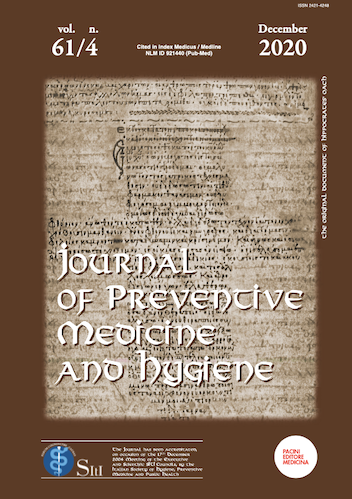Abstract
Introduction. The aim of this study is to describe a proactive surveillance system of food, water and environmental surfaces, in order to avoid Healthcare-Associated Infections (HAIs) from hospital environment.
Methods. It is a retrospective descriptive study. The surveillance system consists of two integrated phases: pre-analytic and post-analytic. The activities are distinguished in ordinary control activities, performed after scheduled and shared surveys, and compliance activities, performed when it is necessary to establish the adequacy of the destination use, for example opening a new ward.
Results. A total of 1,470 Samples were collected and 539 Reports were generated across the five-year study period. Water for human consumption procedure: a statistically significant trend was found only in the total number of Samples collected (p < 0.001). Legionella spp. infection water risk procedure: all Samples and Reports, with the exception of Compliance Report Samples, showed a statistically significant trend (p < 0.001). Pseudomonas aeruginosa water risk procedure: only Ordinary Reports and Compliance Report Samples trend were statistically significant (p = 0.002 and p = 0.028 respectively). Effectiveness of surface sanitization procedure: no trend was statistically significant (p < 0.05). Hospital catering and food surfaces procedure: Samples and Reports yearly number was constant, no trend analysis was performed. HAIs prevalence was never over 5% in the hospital under study.
Conclusions. This surveillance system of water, food and environmental surfaces represents an innovative way of approaching hospital safety for patients and personnel because it overcomes the limitations due to a classic approach limited to a laboratory analytic phase only, according to the best available scientific evidence.
References
2. «https://www.cdc.gov/hai/data/portal/index.html last access: 16.04.2019», s.d.
3. R. Accardi, S. Castaldi, e A. Marzullo, «Prevention of healthcare associated infections: a descriptive study», annali di igiene medicina preventiva e di comunità, n. 2 (30 marzo 2017): 101–15, https://doi.org/10.7416/ai.2017.2137.
4. Kiran M. Perkins et al., «Investigation of Healthcare Infection Risks from Water-Related Organisms: Summary of CDC Consultations, 2014—2017», Infection Control & Hospital Epidemiology 40, n. 6 (giugno 2019): 621–26, https://doi.org/10.1017/ice.2019.60.
5. K. Rietberg et al., «Outbreak of Listeria Monocytogenes Infections Linked to a Pasteurized Ice Cream Product Served to Hospitalized Patients», Epidemiology and Infection 144, n. 13 (ottobre 2016): 2728–31, https://doi.org/10.1017/S0950268815003039
6. Mazengia et al., «Hospital-Acquired Listeriosis Linked to a Persistently Contaminated Milkshake Machine», Epidemiology and Infection 145, n. 5 (aprile 2017): 857–63, https://doi.org/10.1017/S0950268816003198.
7. A. Shetty et al., «Outbreak of Listeria Monocytogenes in an Oncology Unit Associated with Sandwiches Consumed in Hospital», Journal of Hospital Infection 72, n. 4 (agosto 2009): 332–36, https://doi.org/10.1016/j.jhin.2009.01.012.
8. Nguyen L, Garcia J, Gruenberg K, MacDougall C. Multidrug-Resistant Pseudomonas Infections: Hard to Treat, But Hope on the Horizon? Curr Infect Dis Rep. 2018 Jun 6;20(8):23, https://doi.org/10.1007/s11908-018-0629-6.
9. Walter Zingg et al., «Hospital Organisation, Management, and Structure for Prevention of Health-Care-Associated Infection: A Systematic Review and Expert Consensus», The Lancet Infectious Diseases 15, n. 2 (febbraio 2015): 212–24, https://doi.org/10.1016/S1473-3099(14)70854-0.
10. «Linee guida per la prevenzione ed il controllo della legionellosi, Ministero della Salute, Italia (May, 2015)», s.d.
11. «ISO 11731-1:1998 “Water quality-detection and enumeration of Legionella”», s.d.
12. «Examining food, water and environmental samples from healthcare environments. Microbiological giudlines. Public Health E», s.d.
13. «Water systems. Health Technical Memorandum 04-01: Addendum. Department of Health. (2013)», s.d.
14. «Guidelines for the Prevention and Control of Infection from Water System in Health Care Facilities. Health Protection Su», s.d.
15. «Regolamento (CE) 2073/2005», s.d.
16. «Regolamento (CE) 1441/2007», s.d.
17. R. J. Gilbert et al., «Guidelines for the Microbiological Quality of Some Ready-to-Eat Foods Sampled at the Point of Sale. PHLS Advisory Committee for Food and Dairy Products», Communicable Disease and Public Health 3, n. 3 (settembre 2000): 163–67.
18. Wirtanen, G., Salo, S. (2011) - Microbial limits used for various types of food process surfaces based on case study eva», s.d.
19.«Guideline for Disinfection and Sterilization in Healthcare Facilities, 2008 (Update: May 2019) William A. Rutala, David », s.d.
20. «Options for Evaluating Environmental Cleaning Prepared by: Alice Guh, Philip Carling, Environmental Evaluation Workgro», s.d.
21. « European Centre for Disease Prevention and Control. Point prevalence survey of healthcare-associated infections and antimicrobial use in European acute care hospitals –protocol version 5.3. Stockholm: ECDC; 2016.)», s.d
https://academic.oup.com/eurpub/article/29/Supplement_4/ckz186.617/5623829?searchresult=1

